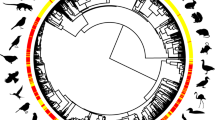Abstract
We examine the first arrival and last departure dates of migrant bird species from, respectively, six and three English area bird reports. Of all 145 bird series, 50% demonstrated significantly earlier arrival in recent years, with the average advance over all species being 0.25 days/year or 12 days earlier over 50 years. Thirty percent of 67 series demonstrated significantly later departure, with the average species delay being 0.16 days/year or eight days later over 50 years. There was greater consistency between species in trends in first arrival than in last departure, with species such as sand martin Riparia riparia significantly earlier at all six sites while, for example, spotted flycatcher Muscicapa striata showed no significant change in arrival at all sites. Significant negative correlations between arrival dates and English temperatures were found for 26% of all series, but temperature effects on departures were less clear. We provide some evidence that trends in arrival dates may be masked by population declines in birds. Since migrant bird populations are in decline generally, this may suggest that the real advance in arrival dates may be greater than that reported here.

Similar content being viewed by others
References
Ahas R (1999) Long-term phyto-, ornitho- and ichthyophenological time-series analyses in Estonia. Int J Biometeorol 42:119–123
Barrett RT (2002) The phenology of spring bird migration to north Norway. Bird Study 49:270–277
Baillie SR, Marchant JH, Crick HQP, Noble DG, Balmer DE, Coombes RH, Downie IS, Freeman SN, Joys AC, Leech DI, Raven MJ, Robinson RA, Thewlis RM (2006) Breeding birds in the wider countryside: their conservation status 2005 (BTO research report no. 435). BTO, Thetford, UK (see http://www.bto.org/birdtrends2005. last cited 8 July 2007)
Baker H, Stroud DA, Aebischer NJ, Cranswick PA, Gregory RD, McSorley CA, Noble DG, Rehfisch MM (2006) Population estimates of birds in Great Britain and the United Kingdom. Br Birds 99:25–44
Bland RL (1999) The timing of summer migrant arrival in the Avon area 1920–1998. Avon Bird Report 1999, pp 141–149
Cotton PA (2003) Avian migration phenology and global climate change. Proc Nat Acad Sci 100:12219–12222
Gregory RD, Wilkinson NI, Noble DG, Robinson JA, Brown AF, Hughes J, Procter D, Gibbons DW, Galbraith CA (2002) The population status of birds in the United Kingdom, Channel Islands and Isle of Man: an analysis of conservation concern 2002–2007. Br Birds 95:410–448
Hüppop O, Hüppop K (2003) North Atlantic oscillation and timing of spring migration in birds. Proc R Soc Lond B 270:233–240
Hüppop O, Winkel W (2006) Climate change and timing of spring migration in the long-distance migrant Ficedula hypoleuca in central Europe: the role of spatially different temperature changes along migration routes. J Ornithol 147:344–353
Jenkins D, Watson A (2000) Dates of first arrival and song of birds during 1974–1999 in mid-Deeside, Scotland. Bird Study 47:249–251
Jenni L, Kéry M (2003) Timing of autumn bird migration under climate change: advances in long-distance migrants, delays in short-distance migrants. Proc R Soc Lond B 270:1467–1471
Lehikoinen E, Sparks TH, Zalakevicius M (2004) Arrival and departure dates. Adv Ecol Res 35:1–31
Loxton RG, Sparks TH, Newnham JA (1998) Spring arrival dates of migrants in Sussex and Leicestershire (1966–1996). Sussex Bird Rep 50:182–196
Mason CF (1995) Long-term trends in the arrival dates of spring migrants. Bird Study 42:182–189
Sparks TH, Carey PD (1995) The responses of species to climate over two centuries: an analysis of the Marsham phenological record, 1736–1947. J Ecol 83:321–329
Sparks TH, Mason CF (2004) Can we detect change in the phenology of winter migrant birds in the UK? Ibis 146(Suppl 1):57–60
Sparks TH, Roberts DR, Crick HQP (2001) What is the value of first arrival dates of spring migrants in phenology? Avian Ecol Behav 7:75–85
Sparks TH, Bairlein F, Bojarinova JG, Hüppop O, Lehikoinen EA, Rainio K, Sokolov LV, Walker D (2005) Examining the total arrival distribution of migratory birds. Glob Change Biol 11:22–30
Tryjanowski P, Kuźniak S, Sparks TH (2005) What affects the magnitude of change in first arrival dates of migrant birds? J Ornithol 146:200–205
Acknowledgments
We thank all those whose observations contributed to the data reported here.
Author information
Authors and Affiliations
Corresponding author
Additional information
Communicated by F. Bairlein.
Appendix
Appendix
Rights and permissions
About this article
Cite this article
Sparks, T.H., Huber, K., Bland, R.L. et al. How consistent are trends in arrival (and departure) dates of migrant birds in the UK?. J Ornithol 148, 503–511 (2007). https://doi.org/10.1007/s10336-007-0193-6
Received:
Revised:
Accepted:
Published:
Issue Date:
DOI: https://doi.org/10.1007/s10336-007-0193-6




